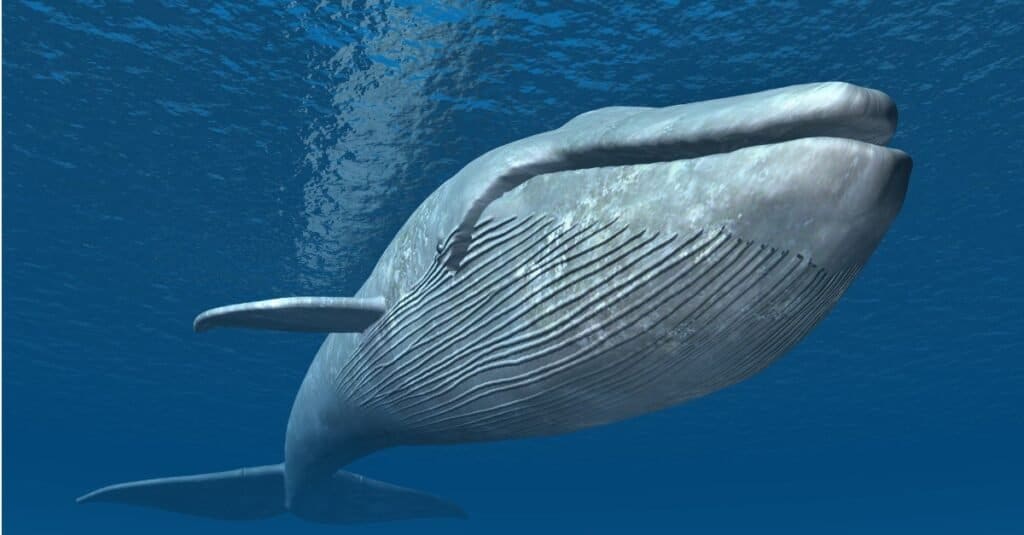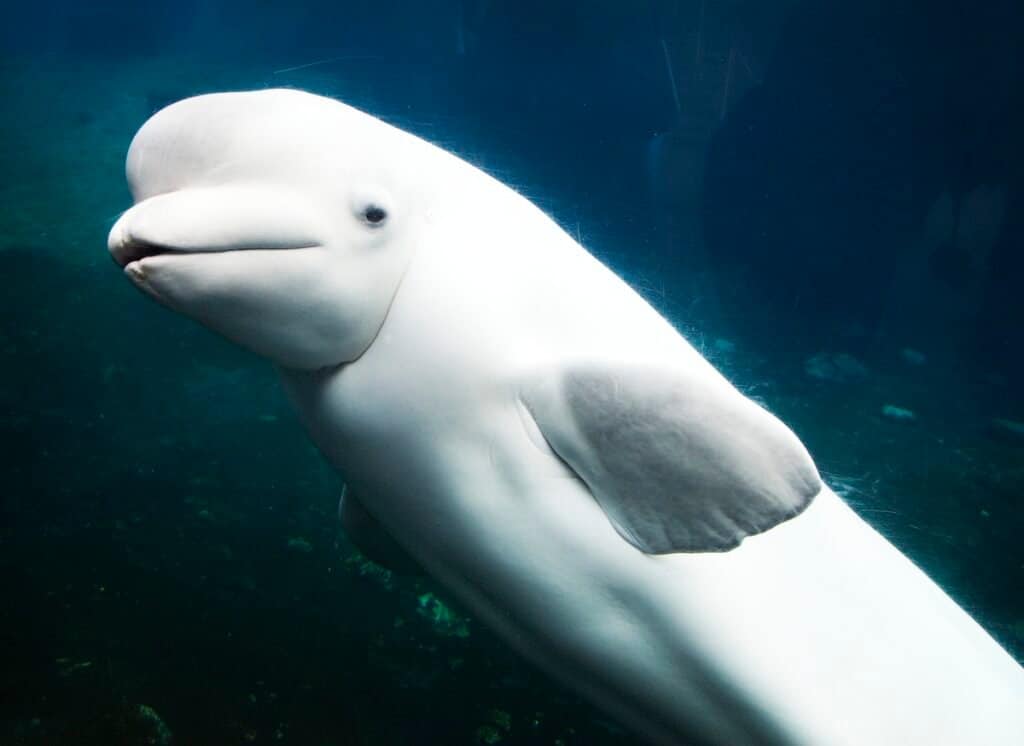Dolphins and whales belong to the same family; they’re all part of the Order Cetacea. However, whales are broken down into baleen whales and toothed whales, so it should be obvious that dolphins are part of the latter. That’s not the only difference between a dolphin vs whale. We’re going to take some time to explore the true differences between dolphins and whales.
Although they belong to the same Order, they have many unique facets to them. Not only will you know how to tell them apart by looking at them, but you will also learn about less obvious differences between them.
Comparing a Dolphin and a Whale

| Dolphin | Whale | |
| Size | Weight: 200 to 660lbs Length: 6.5ft – 13ft | Weight: Up to 352,000lbs (blue whale Length: Up to 100ft (blue whale) |
| Shape | – Leaner, smaller, more torpedo-shaped bodies | – Thicker, larger body with thick deposits of fat |
| Neck Vertebrae | – Vertebrae in the neck are not fused, so their neck is somewhat flexible. – Lateral movement and some dolphins can nod up and down. | – Completely fused vertebrae keep the head steady while the whale is swimming. |
| Social Behaviors | – Live in large social pods that can exceed dozens of dolphins – Some “superpods” can exceed 100 dolphins. – Group hunting behaviors, including Orcas (killer whales) | – Many whales are loners, like blue whales, but others live in small pods |
| Brain Size | – 4.0 EQ, indicating their brain is large compared to their body and that the animal has a high cognitive ability. | – 0.38 EQ, indicating the size of their brain is small and their cognitive abilities may be lower than dolphins. |
The 5 Key Differences Between a Dolphin vs Whale

Whales and dolphins differ in size, social behavior, and brain size.
©iStock.com/MR1805
The biggest differences between dolphins and whales are their body size, social behavior, and brain size. Whales are larger than dolphins; even the biggest dolphin, the orca, is small next to the largest whales.
Dolphins live in pods that consist of dozens of different mammals, but whales often live alone or in small pods that number less than a dozen creatures. Although the brain of a large whale is bigger than a dolphin’s, the relative size of the dolphin’s brain is larger than any whale and closer to that of a human!
Dolphin vs Whale: Size
Whales are larger than dolphins in the vast majority of cases. The only dolphin that can match the size of whales is the killer whale, but that is actually a member of the dolphin family.
The average dolphin can reach a weight of 660lbs and grows about 13ft long, but the orca can reach lengths of 26ft and a weight of 19,000lbs.
All these dolphins pale in comparison to the largest whale of all, the blue whale. This creature can weigh up to 352,000lbs and measure about 100ft at its largest. They’re absolutely massive mammals.
Dolphin vs Whale: Shape

Beluga whales
have similar body shapes to dolphins, but dolphins’ bodies taper off more at their tails.
©Carol M Highsmith / CC0 1.0, Rawpixel – License
Dolphins have a cigar or torpedo-shaped body that is long and lean with their bodies becoming much slimmer toward the tail. Whales are also torpedo-shaped but they’re much larger and thicker. It’s easy to tell these creatures apart because whales tend to have large blubber deposits that make them much rounder than a dolphin.
Between the size and shape differences in whales and dolphins, it’s easy to recognize which animal you have encountered.
Dolphin vs Whale: Neck Vertebrae
Not all the cervical vertebrae in a dolphin’s neck are fused together, but all of a whale’s vertebrae are completely fused. That means dolphins have a greater amount of flexibility in their necks, allowing them to engage in some horizontal and vertical movements like nodding or moving their head from side to side.
That is not to say that dolphins do not have any fused vertebrae. In fact, the bottlenose dolphin has two of its seven vertebrae fused together. Therefore, dolphins have some significant neck movement, but their necks aren’t as flexible as a human’s neck.
Dolphin vs Whale: Social Behaviors

Dolphins can join jobs that number in the dozens or hundreds!
©Chase Dekker/Shutterstock.com
Another major difference between dolphins and whales lies in their social behaviors. Dolphins live in pods that can exceed over 100 animals in size. Several species of whales are loners and do not live in pods, but some whales live in small pods that are typically fewer than a dozen individuals.
Dolphins and whales that live in pods do so for similar reasons: social interactions and group hunting efforts. However, dolphins are much more sociable, bonding with other members of their pod, playing with them, and engaging in complex games.
Studies have even shown that some dolphins will even get together to play with their food before they eat it. These behaviors are not seen in whales, and it helps differentiate these two members of the Order Cetacea from each other.
Dolphin vs Whale: Brain Size

Dolphins are highly intelligent creatures owing to their large, complex brains.
©iStock.com/Lefteris_
Dolphins have a higher brain-to-body size ratio than whales by a large margin. Rather than measuring the sheer mass of the whale’s brain size, we’re going to take a look at the encephalization quotient, also called the EQ. The encephalization quotient is the ratio between the real and predicted brain mass of an animal based on its body size.
The bottlenose dolphin has a 4.0 EQ, and the whale has an EQ of 0.38. The dolphin is an incredibly smart animal, but the EQ indicates that the overall level of cognition for a blue whale is not as developed.
Whales and dolphins might belong to the same Order, but they are far different from each other. The size disparity alone is often enough to tell them apart from each other. Although their size is a clear indicator of what kind of mammal you’re looking at, their shape can help identify them, too.
After all, whales are blubbery and round torpedo-shaped creatures while dolphins are leaner, torpedo-shaped creatures. Of course, when size and shape fail to help in the identification of whales and dolphins, the social alignment of these two creatures also grants insight into their vast differences.
Dolphins are incredibly smart and curious animals by nature, so they are much more likely to live together, play games, and bond with one another than whales. These animals are similar in many respects but they still have major differences.
The photo featured at the top of this post is © Agami Photo Agency/Shutterstock.com
Thank you for reading! Have some feedback for us? Contact the AZ Animals editorial team.






